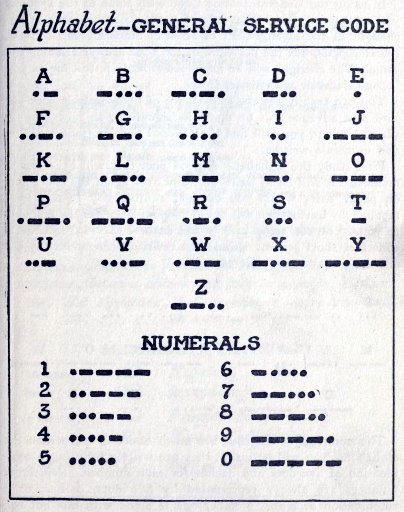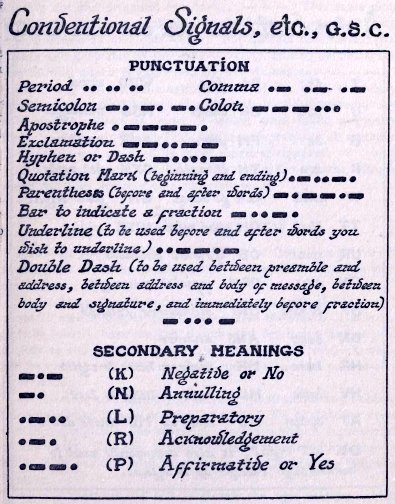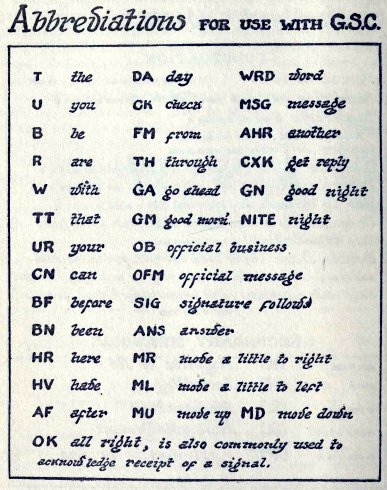GILBERT SIGNAL ENGINEERING
Complete and thorough
instructions in all forms of Signaling
FOR BOYS
BY
LEE CONOVER
Formerly
with Signal Corps U. S. Navy Prepared under the Direction of
A. C. GILBERT
Yale University, 1909
THE A. C. GILBERT COMPANY
NEW HAVEN, CONN.
New York Chicago San
Francisco Toronto London
COPYRIGHT 1920
BY A. C. GILBERT
NEW HAVEN, CONN.
ENGINEERING LIBRARY
TABLE
OF CONTENTS
CHAPTER
I. HISTORY OF SIGNALING 7
II. GENERAL SERVICE CODE AND ITS
USES 14
Wigwag system - The flag, limitations and backgrounds - The torch
and lantern wigwag - Wigwagging by searchlight.
III. GENERAL INFORMATION AND
ADVICE TO SIGNALISTS 27
The message - Duties of a signal unit - Interruption of messages -
Intervals - Code time.
IV. SEMAPHORE SYSTEM 36
The semaphore machine - Two-arm semaphore by hand flags.
V. SOUND AND FLASH LIGHT SYSTEMS
46
Sound signals by bugle - Signaling by pocket whistle - Flashing or
occulting light system - The blinker - The acetylene lantern -
Searchlight signaling - The heliograph - The Ardois system -
The Very system.
VI. TELEGRAPHY, RADIO-TELEGRAPHY
AND TELEPHONY 59
Telegraphy - The American Morse Code Receiving telegraphy -
Radio-telegraphy Telephony - The telephone for signal purposes.
VII. THE SIGNAL TOWER 68
Suggestions for erecting a signal tower - Secret codes and ciphers
- The cipher disc - How to make a cipher outfit.
VIII. MARITIME SIGNALING 77
Flags and correct way of using - Flags of the International Code
and how used - Method of signaling when no other ships are in
sight - Distant signals - International flag waving system.
IX. U. S. NAVY FLAG SIGNALS
85
How navy signals are executed - Calls - U. S. naval flag etiquette
- Time for flying colors - Personal flags - Yacht flags.
X. MISCELLANEOUS SIGNALS 95
International life saving signals - Signals for a pilot -
International distress signals, for day - International distress
signals, for night.
XI. HOW TO MAKE SIGNAL APPARATUS
99
How to make a field buzzer - How to make a heliograph - How to
make a semaphore and blinker.
FOREWORD
To do big things, just as men do
who are experts in a certain kind of endeavor, I believe is the
greatest wish of every boy. I know when I was a boy it was very
interesting to me to find out all I could about electricity,
chemistry and other practical subjects because they held my
attention. There was all kinds of fun in this for me. Whenever I
got working on my experiments I had the greatest amount of
pleasure. Let me tell you, too, I was a happy boy when I had
completed my work and could show it to others.
I remember how I used to watch army men at signal practice. It
was mighty fascinating to see them at the camp with their
apparatus and to observe the methods they used to send messages.
It looked hard, but when I thought it over it seemed very easy.
Signaling will prove just as interesting to you as it did to me,
and because I think it means a great amount of fun for you, I
have had this book prepared by a man who was an expert in
signals and who did very fine work in the Navy as a member of
the Signal Corps. Every detail is explained with the greatest
care. The facts are authentic and you can depend on this book to
give you a thorough knowledge of signaling. You can learn about
signals from the very beginning when firebrands were used in a
primitive fashion many years ago to the present time when
messages are flashed and sent by the most modern inventions.

7 GILBERT SIGNAL ENGINEERING
SIGNAL
ENGINEERING
FIG. 1
Competing teams of the U. S. Army and
Navy on the roof of the Grand Central Palace, New
York City, during a recent signal contest.
Chapter
I
In Webster's Dictionary we find
that the meaning for signal is a sign and in looking up sign
find its definition to be signaling hence they are certainly
very closely related. At any rate a signalman is one who puts
signs into action and that is what we are going to do, By a
little perseverance you will master
8 GILBERT BOY ENGINEERING
each lesson step by step and in
a very short time, with the ease of a master signalman, be able
to flash a message through space for a distance of twenty miles
or more.
The early American Indians wrote their picturegraph messages on
the bark of trees, their canvas wigwams and other conspicuous
places. The totem pole of the Northwest and Alaskan Indians is a
good example of symbol writing. In later years the more advanced
tribes devised crude codes by which they sent messages by means
of smoke.
Many hundreds of years ago the ancient tribes in Europe put into
practice the habit of carving picturegraph stories on rocks.
Like the American Indians, they later found methods of sending
their messages through Space with the aid of a cumbersome
code and lighted torches.
 FIG. 2
FIG. 2
Boy Scouts in mountain of N. Y. State signaling from a
platform erected in a tree.
Courtesy of Boy Scouts of America.
It seems that the earliest forms
of optical telegraphy, as visual signaling is sometimes called,
involved the use of firebrands or torches. Of course these could
only be used at night and , and his-
9 GILBERT SIGNAL ENGINEERING
 FIG. 3
FIG. 3
Boys practicing signals at a Scout Camp. Courtesy of
Boy Scouts of America
 FIG. 4
FIG. 4
Boy Scouts of a Denver, Colo., Troop practicing semaphore.
Courtesy of Boy Scouts of America
10 GILBERT BOY ENGINEERING
tory gives us no reliable
records of any day signals until the earlier forms of semaphore
hundreds of years later.
About 200 B. C. a method of signaling was employed by the
Greeks, in which torches were used. A system of measuring the
flashes or exposures so as to make a simple code was invented.
The Romans also used torches for signaling, and during the early
Greek and Roman Wars probably the first step was taken in Signal
Corps organization. These warrior signalmen were known as "fire
shakers," and to obtain points of vantage they built in many
places throughout Europe signal stations, some of which are
still standing to this day.
Mention is made in the Old Testament of lighting signal fires
for the purpose of conveying intelligence. It seems that the
method of using signal fires and torches was very popular among
the early signalmen. The fact remains that even as late as the
Civil War in America torches were still in use by the Signal
Corps of the Blue and Gray Armies and are rivaled today only by
the more modern devices in which lanterns and electric lights
are used.
In the year 1623 the Marquis of Worcester (England), invented a
plan of letters for signaling by day and night.
Monsieur Amontons (France 1663) recommended the holding up of
large letters of the alphabet to be viewed by telescope.
Robert Hook of England was the first to really develop the
modern idea of visual signaling. He used various shaped objects,
suspended on a frame, to indicate letters of the alphabet.
Claude Chappe, a young French engineer, in 1790 invented a
system of semaphore, and other Frenchmen followed him with the
more advanced forms of indicators with semaphoric wings.
During the reign of Queen Elizabeth, the Duke of York (later
James II) introduced a system of methodized signals from which
later sprang the first British Naval Code.
11 GILBERT SIGNAL ENGINEERING
 FIG. 5
Signalmen of the U. S. Navy on
signal bridge of the U. S. "Wyoming"
FIG. 5
Signalmen of the U. S. Navy on
signal bridge of the U. S. "Wyoming"
12 GILBERT BOY ENGINEERING
In 1816 Sir Home Popham of the
British Navy gave the world a new system of semaphore telegraph,
which was adopted by the British Admiralty.
William Penn of America is also given credit for being among the
first (if not the first) to get together a code and system for
communication at sea.
In reviewing the history of signaling it might be of interest to
know that the first telescope was invented about the year 1600.
This important invention increased the range of the naked eye to
a very great extent and made signaling an important method of
communication.
The needs for signaling, we can see, were first wanted by armies
so as to bring about rapid exchange of thoughts. It proved
faster and more reliable than messengers, who were always
subject to delays or liable to capture. Still, today, its
paramount use is found in the armies and navies of the world,
where the Signal Corps is without a doubt the most important
branch.
In November, 1863, during the Civil War in America, when General
Grant took command of the Union Army before Chattanooga he
established his Signal Corps on a big mountain and was able
to keep in touch with his forces during many of the great
battles, one of which was the famous "Battle Above the Clouds"
fought on Lookout Mountain. Today this mountain, from which his
Signal Corps operated, is called Signal Mountain and will stand
as an everlasting monument to the Signal Corps. If it is ever
your good luck to visit this beautiful spot in Tennessee you
will then realize to what extent accurate signals were and can
be exchanged.
During the late war the Allied armies used many ingenious
methods of signaling, including the improved blinker systems,
sound systems and radio. One of the newest schemes is that of
sending a message from the ground to aeroplanes by means of
13 GILBERT SIGNAL ENGINEERING
"Panels." This is done with a
code and panels of colored cloth laid on the ground.
The importance of Signal Corps work can be realized better when
it is known that the Signal Corps of the U. S. Army alone,
during the time it took part in the war, used 126,000 miles of
wire for intelligence communications by telephone and telegraph
lines. (Liaison work.)
More scientific knowledge of our neighboring planets will
undoubtedly be accomplished by means of high powered signal
apparatus. The matter of an exchange of messages with the
inhabitants (if any) of these planets is receiving serious
thought by many scientists. Several years ago a plan was
advanced to do this by means of the heliograph method. This
scheme was to use great mirrors with a huge shutter arrangement
so as to send the messages by means of great flashes. Who can
tell but what you may be able to invent the apparatus to send a
message that far? It would, of course, take years to develop,
but some one will eventually find a way to complete this wonder
system in signaling.
14 GILBERT BOY
ENGINEERING
Chapter
II
GENERAL SERVICE CODE AND ITS
USES
A code of signals is a
collection of symbols agreed upon. The International Morse or
Continental Code is the most widely used of all modern codes due
to its easy adaptability to so many forms of signaling.
The International Morse Code was first used for transmitting
messages by ocean cables and later adopted by the armies and
navies of the United States and Great Britain. By the official
recognition of the Army and Navy, the Boy Scouts and other
organizations it has come to be known as the "General Service
Code." From this point on in the book it will be called by that
term.
The General Service Code is a code of dots and dashes comprising
the twenty-six letters of the alphabet and the numerals, with
additional symbols.
The following signal systems are
based on this code:
1. Sound system.
2. Heliograph system.
3. The Ardois system.
4. Flashing or occulting light system.
5. Very's night system.
6. The Wigwag system.
7. Radio.
8. Buzzer and Field Telegraph.
The U. S. Army, commercial
telegraph lines and short cables at the present time use the
American Morse which has slightly different symbols.
15 GILBERT SIGNAL ENGINEERING
CHART
1
16 GILBERT BOY ENGINEERING
In using the General Service
Code with some of the systems just mentioned, it is necessary at
times to make some minor changes in the arrangement of sending
numerals and conventional signals, but the principle of the code
always remains the same. The changes will be explained from time
to time as you become familiar with the systems.
You can readily see the importance of knowing this code before
any advance can be made in signaling; so now turn to Chart
1 where you will find the General Service Code alphabet and
numerals written.
First study the alphabet. A good plan that will help you
to memorize it will be to write over and over again the
characters on paper, after which you can get another boy to test
your memory by having him call out at random letters of
the alphabet to you. You can reply in dots and dashes. Another
way is to construct short sentences and then rewrite them under
the dot and dash characters. For example;
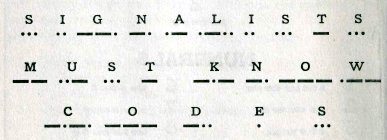
The numerals of the code are
much easier to learn than the alphabet. You will note that they
are written by using a combination of five dots and dashes for
each number. Remember numbers are always represented by five
dots, dashes, or a combination of both. Number one is made with
one dot followed by four dashes, . - - - - ; number two by adding
17 GILBERT SIGNAL ENGINEERING
CHART
2
18 GILBERT BOY ENGINEERING
CHART
2 CONT'D.
19 GILBERT SIGNAL ENGINEERING
another dot and dropping one
dash, . . - - -.
This same plan is followed until you reach number six, when you
start with one dash followed by four dots - . . . For number seven
write two dashes and drop one of the dots, - - . . . , and
so on down the line to zero which is expressed by five dashes - - - - -
Chart 2 gives the punctuation marks of the code, secondary
meanings of several letters of code alphabet, conventional
signals and abbreviations, most of which were taken originally
from the American Morse Code but are adaptable to all methods of
signaling and are used by every practical signalist.
In using abbreviations, no matter what the system, always
remember they are sent as a complete word.
THE
WIGWAG SYSTEM
Now that you know the General
Service Code, you are ready to make use of this knowledge by
practicing short messages with the Wigwag System.
In the Army, for practicing the wigwag, a stick of light wood
about 18 inches long is used, and is called the wand. The wand
is held loosely between the thumb and forefinger and waved
rapidly to right or left to indicate letters of the code. A wand
can be made easily from the small end of a bamboo pole or any
light wood.
By referring to Chart 3 you will see illustrated a boy holding
the single stick flag at position or ready. He is standing erect
and facing squarely the receiving station which is represented
on the chart. The flag is held vertically in line with center of
head. This position with three motions constitutes the Wigwag
System.
On the chart at the left is shown the first motion, which
represents the dot. To make this motion the flag is waved from
position to right of sender and back to position. This mo-
20 GILBERT BOY ENGINEERING
 FIG. 6
Members of a U. S. Marine
Signal Corps Company wigwagging from a signal tower erected on
roof of a building at Vera Cruz, Mexico
FIG. 6
Members of a U. S. Marine
Signal Corps Company wigwagging from a signal tower erected on
roof of a building at Vera Cruz, Mexico.
Courtesy of U. S. Marine Corps
tion is always made in a plane
at right angles to the line connecting the two stations as shown
in center of your chart.
The second motion shown on right of chart gives you the dash and
is made exactly as above only to left of sender.
The third motion shown at bottom of the chart is made by a wave
of the flag from position directly in front of sender to your
feet, and instantly returning to position or ready. This third
motion represents front or interval. One front motion is given
at end of each word, two at end of a sentence and three upon
completion of a message. In making a letter of the alphabet say
the letter Q four strokes are made ; i. e. LEFT LEFT RIGHT LEFT.
It is not necessary to pause at position in going from extreme
left to right or vice versa. However, a slight pause should be
allowed
21 GILBERT SIGNAL ENGINEERING
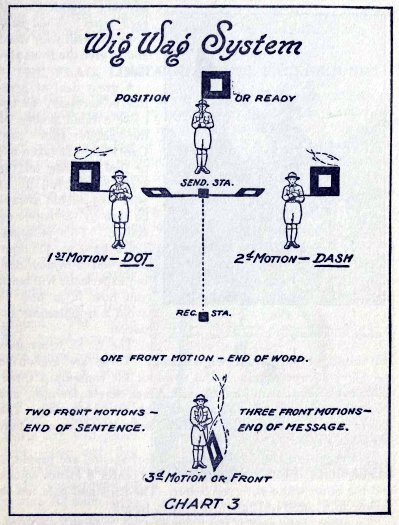 CHART 3
CHART 3
22 GILBERT BOY ENGINEERING
at the completion of each
letter. Then continue to finish your word and to give the front
signal.
A great deal of practice is necessary to become a rapid sender
by the single stick flag. Care should be taken not to foul the
flag on the staff, as the full fly of your flag should always be
seen by the receiving station. This is sometimes hard to do,
especially on a windy day, but experience will teach you how it
is best to avoid a troublesome situation.
The U. S. Army uses two standard outfits for wigwagging. These
are known in the Signal Corps as kits. The two-foot kit contains
a three-jointed hickory staff, jointed with brass screw
ferrules, and when fitted together makes a strong pole 69 inches
long. The flag is made fast to pole by means of three ties of
tape. These are looped through brass eyes on pole.
Two flags, the size of each being 2 feet square, are provided,
one of bright red material with a white center 8 inches square
and the other white with red center. The flags and pole can be
packed in a canvas kit about 2 feet in length.
The other outfit used is the "four-foot kit." In this outfit the
 FIG. 7
Boy Scouts sending a message
by two-arm semaphore.
FIG. 7
Boy Scouts sending a message
by two-arm semaphore.
Courtesy of Boy Scouts of America
23 GILBERT SIGNAL ENGINEERING
pole is heavier and when jointed is 12 feet in length. The two
flags are 3 feet 9 inches square with 12-inch centers; they are of
alternating colors, red and white, as in the smaller outfit.
THE
FLAG, LIMITATIONS AND BACKGROUNDS
The size of the wigwag flag to
be used depends entirely on the distance you want to transmit a
message, and whether or not the receiving station is equipped
with glasses. Under ordinary conditions a flag of 18 inches or 2
feet can be read a distance of one mile without glasses and two
miles with glasses. This is the extreme limit for a flag of that
size.
Nearly all single stick flags are made up of a combination of
red and white colors, as these colors usually give greatest
contrast. Red and orange is also a good combination.
Always select the color of your flag so as to give greatest
possible contrast against the background. The white flag should
never be used where your background is a snow-covered hill or
light sky; but if sky is heavily clouded a white flag will prove
best. The red flag should be used against a light background, of
course. As some backare very de-
 FIG. 8
Boy Scouts of Ansonia, Conn.,
sending a long distance wigwag message at sundown
FIG. 8
Boy Scouts of Ansonia, Conn.,
sending a long distance wigwag message at sundown.
Courtesy of Boy Scouts of America
24 GILBERT BOY ENGINEERING
ceiving at times, it will take a
little study on your part to determine the proper flag to use
for particular conditions.
THE
TORCH AND LANTERN WIGWAG
At night the signal flag is of
no use; the substitute is either the torch or lantern.
If you are out in the woods and want to send a message at night
to an adjoining camp and have no torch or lantern at hand it is
great fun to use firebrands. Selected sticks of dry wood can be
placed in the camp fire and lallowed to burn a minute or two.
The signalist can then send a message to his comrades. It will
surprise you to learn the distance you can send messages by this
method. Care should be taken to get out of range of your camp
fire, as its reflection would hinder the receiving party.
Signaling at night is always subject to
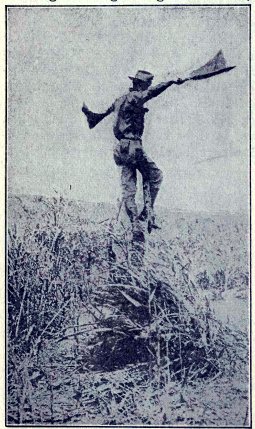 FIG. 9
A U. S. Marine semaphoring,
Haiti, West Indies.
FIG. 9
A U. S. Marine semaphoring,
Haiti, West Indies.
Courtesy of U. S. Marine Corps
25 GILBERT SIGNAL ENGINEERING
 FIG. 10
U. S. Army Signal Corps on
Mexican Border
FIG. 10
U. S. Army Signal Corps on
Mexican Border
more adverse conditions than by
day. Therefore it is advisable to send messages much slower at
night. Where the distance is great, an additional light should
be placed in line with center of your body and about 2 feet from
the ground to act as an indicator or point of reference in the
motion.
About the most practical way of wigwagging at night is to
use two lanterns, one for the indicator and the other for
transmitting. Care should be given at night to the front motion,
so as to make it distinct. This motion can be simplified
somewhat by moving the lantern vertically from your head to your
indicator light. For long distances you can fasten a lantern to
a pole.
"The Science Notebook"
Copyright 2008-2018 - Norman Young
 The
Science Notebook
The
Science Notebook The
Science Notebook
The
Science Notebook






